The Prichard House
Introduction
Text-to-speech Audio
Images
The Prichard House- every block of granite was individually cut to correspond with the over all pattern.
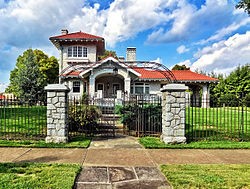
The Prichard House
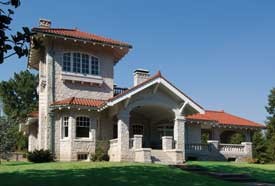
The Prichard House, pictured in 2000
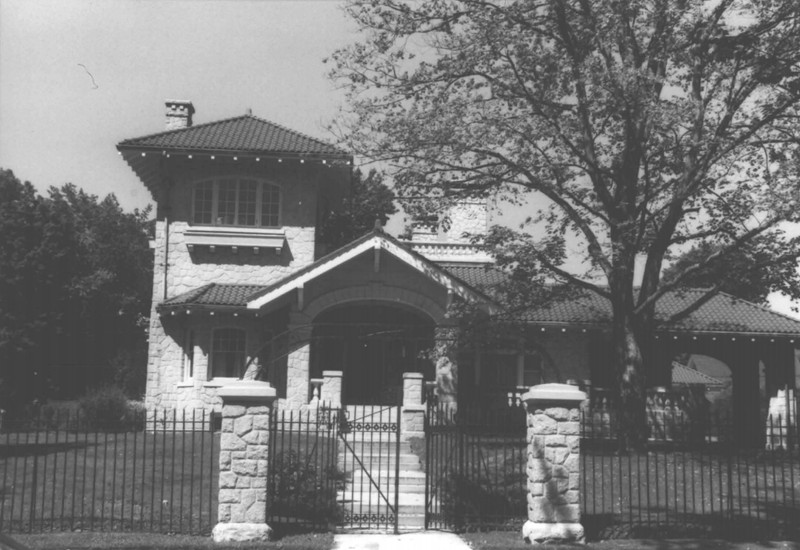
The Hotel Prichard
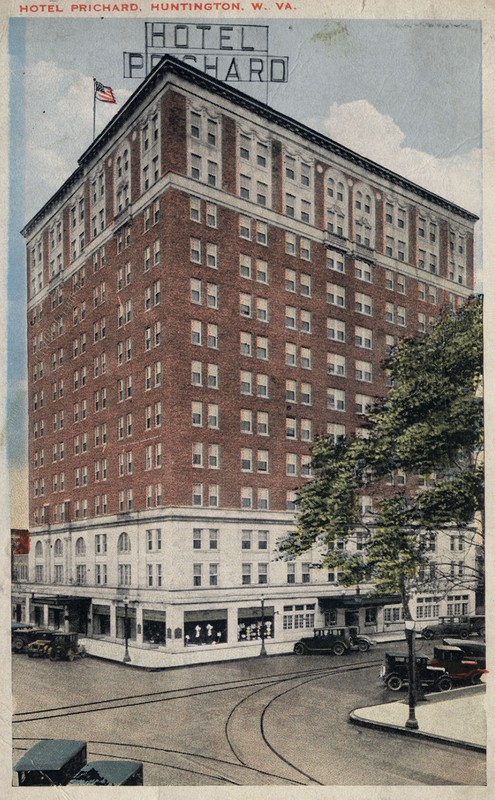
The Prichard School in Ona, WV
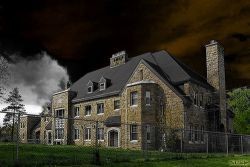
Backstory and Context
Text-to-speech Audio
Frederick C. Prichard was born in Grayson, Kentucky in 1871. He was the son of Lewis Prichard, Jr., a doctor who became a real estate and coal industry mogul when he moved his family to Charleston, West Virginia in 1884. Frederick Prichard earned a degree in civil engineering from Notre Dame University and became a coal operator, which eventually led him to make a small fortune in the coal fields of Fayette County. He married Alice Clare Wilson on October 24, 1894. In 1909, Prichard and his wife moved to Huntington, where they would build two prominent downtown buildings and one of the city’s most unique homes.
Frederick Prichard and his business partner, Houghton A. Robson, bought real estate in downtown Huntington in order to establish business offices. The result was the Robson-Prichard Building, which has since been known as the Chafin Building and the Guaranty Bank Building. Cincinnati architects Elzner and Anderson developed the plans for the 10-story building, which had 175 office spaces, fireproof vaults, combination locks in all offices, a vacuum steam heating system, ice water fountains on each floor, hot and cold water in each room, and lighting by bottled gas and electricity. The Huntington Bank and Trust Company inhabited the first floor, and Prichard eventually became the president of the bank.
The Prichards started construction on their home in 1921 following the success of the Robson-Prichard building. Locating the house on a full-acre site at 12th Avenue and 5th Street, the Prichards chose gray granite instead of the usual red brick to design a home topped with a Spanish tile roof and a tower. The main house, along with the guesthouse/garage and chicken house, were designed in the Italian Renaissance style, which was popular in the United States from around 1890 to 1930. Although the style was popular in the country at large, it was not very common in Huntington, leading the Prichard House to stand out when compared to its neighbors. The house’s builder, John J. West, was known for his attention to quality and detail, which is reflected in the fact that every block of granite was individually cut to correspond with the overall pattern of the house’s exterior. The Pittsburgh firms of Joseph Home Company and Boggs and Buhl Co. provided the interior finishing, door knobs and bath fixtures, and the local Wilson Cabinet Company supervised the woodwork inside the house. The home ultimately cost $300,000 and was completed in 1923.
The Prichards, who had no children of their own, also decided to start a project that would help those in need. The couple developed a plan to build both a school for orphaned children and a hotel, the Hotel Prichard, that would financially support one another. On April 20, 1924, the Prichard School's board of trustees was established and construction of the school began. In 1927, the school opened in Ona, WV. It was a working farm with cattle where children earned an education along with training in how to raise cattle and cultivate crops. The Hotel Prichard opened in 1926 with three hundred guest rooms, each with its own bathroom and outdoor exposure. The Prichard School supplied the kitchen at the hotel, while the profits from the hotel supported the school financially.
Unfortunately, the Prichards’ philanthropy proved short-lived. As the hotel failed to bring in enough revenue and the coal industry declined, the Prichards decided to take their endeavors to Texas:
"I am just about even. I have arranged to rent a small Texas farm on credit. I expect to plant some citrus trees. I have no regrets. Business provides some stimulating experiences and I enjoyed all of these during my business career. The Prichard School is the owner of real estate worth at least $1,500,000 and will develop as has been planned. I expect to come back." -Fred Prichard in the Cleveland Plain Dealer, 1928.1
The Prichards visited the school regularly, but never again resided in West Virginia. Prichard lost most of his fortune in the Great Depression and was forced to sell his hotel. He died in 1960 at age 89. In 1970, the Hotel Prichard closed and was renovated to offices and apartments. By the 2000s, the former hotel had become associated with crime and drug activity. The Prichard was briefly rebranded as a drug rehabilitation facility called Hope Tower in 2014, before being closed for building code violations in 2015. In 2016, it was announced that Christ Temple Church had acquired the Prichard and was in the process of renovating the structure, but the church’s plans for the building have not been publicly released.
In 1926, the Prichard House was deeded to Prichard’s younger brother. According to the Huntington City Directory, the Prichards then moved into their hotel while the brother and his family moved from Virginia to live in the house. However, the family reportedly claimed that the house was too small and moved out within a year. From 1927 to 1950, the house variously sat vacant or was used as a rental property. Mrs. Mabel McClintock Ritter, the widow of Lloyd Charles Ritter, for whom Ritter Park was named, purchased the home for $53,000 in 1950. Mrs. Ritter fixed previous issues with the house and updated the interior to her liking, including fixing the leaking roof by installing a tar paper and gravel roof. In 1961, Jessie Vaughan Ratcliff, the wife of Gilbert A. Ratcliff, M. D, one of Huntington's leading obstetricians, purchased the Prichard House for $60,000. Today the home is still a private residence, and many Huntington residents remain unaware of the house’s connection to the development of downtown Huntington.
Sources
1. “National Register of Historical Places Nomination Form.” Accessed November 16, 2016. http://www.wvculture.org/shpo/nr/pdf/cabell/01000261.pdf.
2. Casto, James. “Lost Huntington: The Hotel Prichard.” October 26, 2015. Accessed November 16, 2016. http://www.herald-dispatch.com/lost-huntington-the-hotel-prichard/article_e9a0eae6-39ac-5b98-bcab-4a....
3. Pewitt, Rebekah. The Prichard Building Becomes Hope Tower. September 21, 2014. http://www.wsaz.com/home/headlines/The-Prichard-Building-Becomes-Hope-Tower-275946171.html.
4. Hardiman, Jean. “Prichard Hotel Owner Aims to Restore Former Glory of Building.” October 16, 2015. Accessed November 16, 2016. http://www.herald-dispatch.com/business/prichard-hotel-owner-aims-to-restore-former-glory-of-buildin....
https://huntingtonquarterly.com/articles/issue63/architecture.html
http://www.wvculture.org/shpo/nr/pdf/cabell/01000261.pdf
https://www.herald-dispatch.com/business/prichard-hotel-owner-aims-to-restore-former-glory-of-building/article_c35a5b0a-abda-51db-ad48-af5e5e4025ae.html
http://cabellcountydoorstothepast.com/history/prichard.htm
